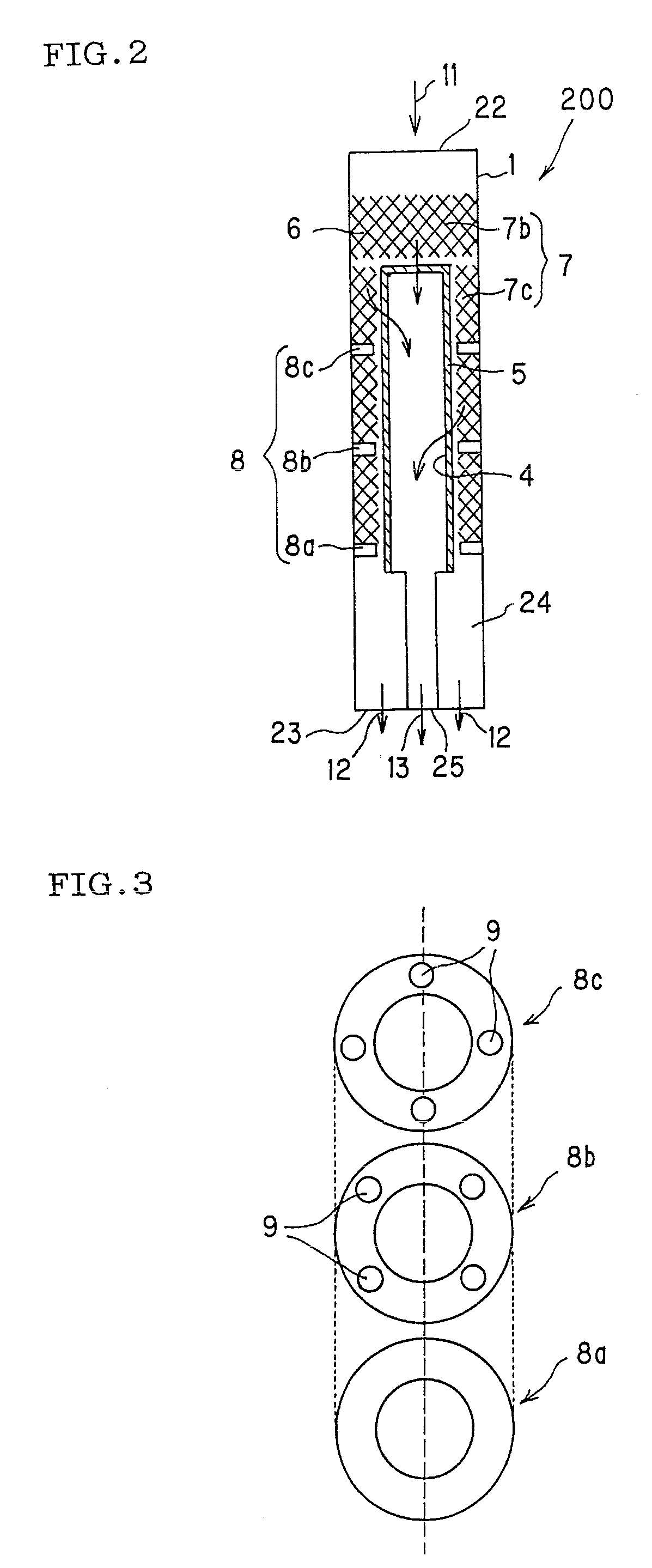Reactor of selective-permeation membrane type
a membrane reactor and selective technology, applied in the direction of membranes, separation processes, physical/chemical process catalysts, etc., can solve the problems of large decrease in separation/recovery efficiency, physical and chemical damage of selective membrane, and inability to achieve sufficient mixed gas separation effect, etc., to achieve high porosity, large pore size, and high permeation rate
- Summary
- Abstract
- Description
- Claims
- Application Information
AI Technical Summary
Benefits of technology
Problems solved by technology
Method used
Image
Examples
example 1
[0084] A selectively permeable membrane reactor was produced which has the same shape as the selectively permeable membrane reactor 100 shown in FIG. 1. An alumina porous body (outer diameter: 10 mm, length: 75 mm) in the shape of a bottomed cylinder of which one end was closed was used as the separation tube. A palladium (Pd)-silver (Ag) alloy film selectively allowing hydrogen to pass through was formed by plating on the surface of the alumina porous body as the selectively permeable membrane. The composition of the film was adjusted so that Pd was 75 mass % and Ag was 25 mass % taking hydrogen permeability into consideration. The thickness of the film was 2.5 μm. As the catalyst, a slurry including a powdered ruthenium catalyst was carried by dipping over the entire surface of a disk-shaped foamed body (corresponding to the foamed body 7b in FIG. 1) and a cylindrical foamed body (corresponding to the foamed body 7a in FIG. 1). The disk-shaped foamed body was formed of cordierite ...
example 2
[0085] A selectively permeable membrane reactor was produced which was similar to the selectively permeable membrane reactor 200 shown in FIG. 2. An alumina porous body (outer diameter: 10 mm, length: 75 mm) in the shape of a bottomed cylinder of which one end was closed was used as the separation tube. A palladium (Pd)-silver (Ag) alloy film selectively allowing hydrogen to pass through was formed by plating on the surface of the alumina porous body as the selectively permeable membrane. The composition of the film was adjusted so that Pd was 75 mass % and Ag was 25 mass % taking hydrogen permeability into consideration. The thickness of the film was 2.5 μm. As the catalyst, a slurry including a powdered ruthenium catalyst was carried by dipping over the entire surface of a disk-shaped foamed body (corresponding to the foamed body 7b in FIG. 2) and a cylindrical foamed body divided into three sections (corresponding to the foamed body 7c in FIG. 2). The disk-shaped foamed body was ...
example 3
[0086] A selectively permeable membrane reactor similar to the selectively permeable membrane reactor 200 shown in FIG. 2 was produced in the same manner as in Example 2 except that the disk-shaped and cylindrical foamed bodies had a porosity of 90%.
PUM
| Property | Measurement | Unit |
|---|---|---|
| pore size | aaaaa | aaaaa |
| porosity | aaaaa | aaaaa |
| distance | aaaaa | aaaaa |
Abstract
Description
Claims
Application Information
 Login to View More
Login to View More - R&D
- Intellectual Property
- Life Sciences
- Materials
- Tech Scout
- Unparalleled Data Quality
- Higher Quality Content
- 60% Fewer Hallucinations
Browse by: Latest US Patents, China's latest patents, Technical Efficacy Thesaurus, Application Domain, Technology Topic, Popular Technical Reports.
© 2025 PatSnap. All rights reserved.Legal|Privacy policy|Modern Slavery Act Transparency Statement|Sitemap|About US| Contact US: help@patsnap.com



